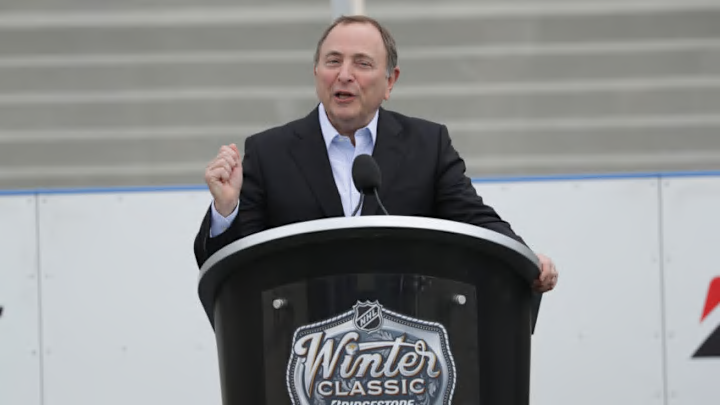For all of the NHL’s institutional issues whether it be concussions, small market team competitiveness or fans just booing Gary Bettman, the league is trending upwards. The increasing salary cap benefits a team like the New York Rangers specifically.
Even though NHL commissioner Gary Bettman is still actively serving in his role, he was elected to the Hockey Hall Of Fame last year. Under his watch, the NHL has grown at an exponential rate in spite of multiple work stoppages. Since the most recent lockout that shortened the 2013 season to just over 40 games, the salary cap for the league has increasingly grown.
While the league has a long way to go in terms of developing a true competitive balance. There is still an assortment of teams that for whatever reason have an owner or ownership group that isn’t fully committed to putting the best possible product on the ice. In turn, these are also the owners that fight for things like offer sheets, revenue sharing and of course, the salary cap.
The salary cap was first introduced to the NHL following the 2004-2005 lockout-canceled season as a means of reigning in absurd contracts that were prevalent in the league. The New York Rangers were paying veteran Bobby Holik more than $9 million per season for 56 points during the 2003-2004 season.
In its first year, the cap was $39 million and has gradually increased over time. This current season, teams are allowed to spend up to $79.5 million which is expected to increase again this upcoming summer. This increase in the salary cap over time was not accompanied by a drastic jump in player salaries or the public perception of them.
Aside from outliers like the Edmonton Oilers deal with center Connor McDavid or John Tavares with the Toronto Maple Leafs, most players fall into the sweet spot of between $5 and $7 million per year once they’re eligible for free agency. This hasn’t changed since the last lockout and it’s in part forcing players out the door earlier than they should be.
Recent history
As part of general manager Jeff Gorton’s plan to rebuild the Rangers in the long-term, he’s done a masterful job of cleaning the team’s books for the future. The team only has two players under contract past the 2021-2022 season, center Mika Zibanejad and defenseman Brady Skjei, both of which are on reasonable contracts.
However, New York’s jettison of both Ryan McDonagh and Kevin Hayes in the past 14 months draws a reasonable response, could the team have afforded to keep either or both in the fold. Let’s ignore the idea of totally bottoming out this season in hopes of getting a top-five pick in the lottery for the sake of this hypothetical.
Since getting traded to the Tampa Bay Lightning, McDonagh agreed to a seven-year extension worth $6.75 million per year. That figure is roughly nine percent of the team’s cap space for this current season, something that is only going to decrease with time as the cap continues to increase with time.
For a player that could easily still be the Rangers number one defenseman, roughly nine percent of the team’s cap is a reasonable investment. Sure, there’s the added risk of signing a player through their mid-30s, especially one with an injury history like McDonagh’s, but value shopping is key to long-term NHL success.
Turning over to Hayes, the rumor circulating prior to this year’s deadline was that the Boston College product was seeking $7 million per season and a seven-year deal. At face value, that seems like a lot for a player who’s having his best statistical season in a walk year on an outright bad team.
But, again, like McDonagh, Hayes’ $7 million per year isn’t that ridiculous of an ask. That figure is about nine percent of the Rangers’ cap for a second line center with an offensive upside that can also start in the defensive zone and contribute on both special teams units.
The future
Going forward, the Rangers are going to need to be diligent with their cap allocation for both outside talents and in house pieces. Most of the team’s important building blocks are still on their entry-level deals or have yet to sign one. The foundation for most successful teams in today’s NHL revolves around a core on these cheap contracts.
However, with players like Pavel Buchnevich, Tony DeAngelo, Neal Pionk and Brendan Lemieux all due for restricted free agency this summer, pay bumps are in order. Of this grouping, three (Buchnevich, DeAngelo and Lemieux) look to figure into the Rangers’ plan for the future based on play this season.
It’s in the team’s best interest to avoid bridge contracts and instead look for multi-year deals that buy years of free agency up front. These are the type of deals that save the team money in the long-term and age better with an increasing salary cap. Giving Buchnevich four years at $3 million per season seems like a lot, but over time it’s the contract that ages well.
Look to the Nashville Predators’ model of signing in house talent early. It’s in part why that organization was able to build such a cost-effective defense around players like Roman Josi, Ryan Ellis and Mattias Ekholm because it was willing to take risk up front to save money in the long-term.
The Rangers are in a position to build from within and compliment that group with outside talent. However, it’s important that the decision makers understand an increasing cap makes long-term extensions more favorable.
